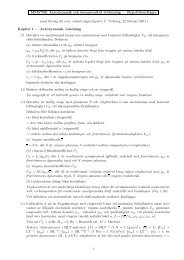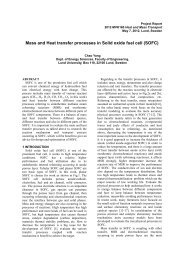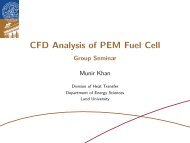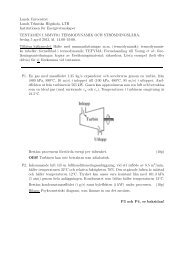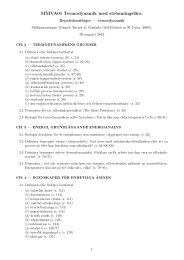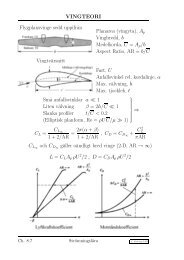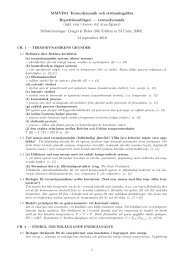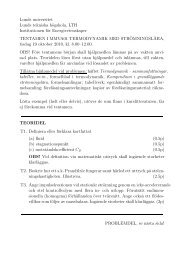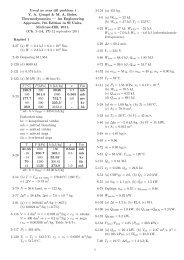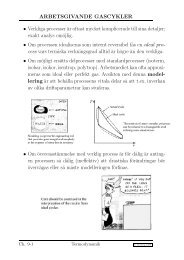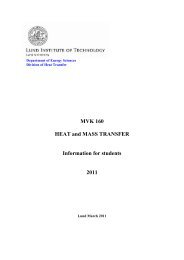Heat Transfer in Gas Turbine Combustors - Värmeöverföring
Heat Transfer in Gas Turbine Combustors - Värmeöverföring
Heat Transfer in Gas Turbine Combustors - Värmeöverföring
You also want an ePaper? Increase the reach of your titles
YUMPU automatically turns print PDFs into web optimized ePapers that Google loves.
Project Report<br />
2012 MVK160 <strong>Heat</strong> and Mass Transport<br />
May 7, 2012, Lund, Sweden<br />
<strong>Heat</strong> <strong>Transfer</strong> <strong>in</strong> <strong>Gas</strong> Turb<strong>in</strong>e <strong>Combustors</strong><br />
William Wiberg<br />
Dept. of Energy Sciences, Faculty of Eng<strong>in</strong>eer<strong>in</strong>g,<br />
Lund University, Box 118, 22100 Lund, Sweden<br />
ABSTRACT<br />
The heat transfer <strong>in</strong> a gas turb<strong>in</strong>e combustor can be separated<br />
<strong>in</strong>to convective, radiative and conductive heat transfer. As far as<br />
the heat transfer to and from the exposed l<strong>in</strong>er wall is<br />
considered, the conductive part is negligible <strong>in</strong> relation to the<br />
convective and radiative heat transfer. Due to the thermal limit<br />
of the l<strong>in</strong>er wall material, it is of <strong>in</strong>terest to predict the wall<br />
temperatures at the l<strong>in</strong>er wall. This can be done either by<br />
empirical correlations which will give an average temperature,<br />
or by numerical methods which will give a more detailed<br />
temperature distribution. In the numerical approach one has to<br />
model the chemical reactions due to the combustion and also<br />
chose an appropriate turbulence model due to the complex flow.<br />
NOMENCLATURE<br />
C/H<br />
Carbon/hydrogen mass ratio of fuel<br />
D L<br />
L<strong>in</strong>er diameter (can) or height (annular), m<br />
D h<br />
Hydraulic mean diameter, m<br />
G Incident radiation, W/m 2<br />
h <strong>Heat</strong>-transfer coefficient, W/(m 2 K)<br />
h<br />
Enthalpy, J/kg<br />
I<br />
Intensity, W/(m 2 sr)<br />
k<br />
Thermal conductivity, W/(mK)<br />
L<br />
Lum<strong>in</strong>osity factor<br />
l b<br />
Mean beam length of radiation path, m<br />
P<br />
Total pressure, kPa<br />
q<br />
Fuel/air ratio by mass<br />
Re<br />
Reynolds number<br />
s<br />
Slot height, m<br />
S ij Stra<strong>in</strong> rate tensor, s -1<br />
U<br />
Flow velocity, m/s<br />
V i<br />
Mass diffusion velocity vector, m/s<br />
x<br />
Distance downstream of slot, m<br />
Y k<br />
Mass fraction of species k<br />
α<br />
Absorptivity<br />
δ ij<br />
Kronecker delta<br />
ε<br />
Emissivity<br />
κ Absorption coefficient, m -1<br />
μ<br />
Dynamic viscosity, kg/(ms)<br />
ρ Density, kg/m 3<br />
ζ Stefan-Boltzmann constant, W/(m 2 K 4 )<br />
ω k Formation rate, kg/(m 3 s)<br />
INTRODUCTION<br />
<strong>Gas</strong> turb<strong>in</strong>es are widely used <strong>in</strong> aircrafts and <strong>in</strong> <strong>in</strong>dustrial<br />
processes due to the relative high specific work output. <strong>Gas</strong><br />
turb<strong>in</strong>es are also commonly used as back-up and primary power<br />
generators due to the fast ramp-up speed of a gas turb<strong>in</strong>e. The<br />
specific power output of the gas turb<strong>in</strong>e is ma<strong>in</strong>ly limited by the<br />
pressure rise that the compressor is able to deliver and the<br />
temperature rise <strong>in</strong> the combustor. With the ambition to<br />
<strong>in</strong>crease the combustion temperature to achieve higher power<br />
output, there is a need to predict the temperature <strong>in</strong> the exposed<br />
materials <strong>in</strong> the combustor and to identify where possible hotspots<br />
can occur.<br />
PROBLEM STATEMENT<br />
Figure 1 shows a combustor and the ma<strong>in</strong> airflows with<strong>in</strong>. Fuel<br />
is supplied through the fuel <strong>in</strong>jector and <strong>in</strong>itially mixed together<br />
with only a part of the <strong>in</strong>let airflow. Some of the cold airflow is<br />
supplied through the l<strong>in</strong>er wall cont<strong>in</strong>uous along the combustor<br />
length to achieve a satisfy<strong>in</strong>g combustion and to cool the l<strong>in</strong>er<br />
wall. The rest of the cold airflow, if no air for blade cool<strong>in</strong>g is<br />
needed, is mixed together with the hot gas at the outlet of the<br />
combustor to achieve an acceptable temperature profile which<br />
fulfills the demands for the turb<strong>in</strong>e <strong>in</strong>let.<br />
Figure 1 (Genrup, 2012)<br />
Figure 2 shows components of the heat flux <strong>in</strong> an element of<br />
the l<strong>in</strong>er wall (1).<br />
Copyright © 2012 by William Wiberg
In real application the l<strong>in</strong>er wall can’t be seen as a black body<br />
and Lefebvre (1) suggested that <strong>in</strong>troduc<strong>in</strong>g the factor<br />
0.5(1+ε w ) <strong>in</strong>to Eq. 3 should compensate for that effect. Further,<br />
Lefebvre suggests that the ratio<br />
α g<br />
ε g<br />
= T g<br />
T w 1<br />
1.5<br />
is a valid approximation. With these assumptions Eq. 3 can be<br />
written as<br />
Figure 2<br />
With direction of the fluxes as <strong>in</strong> Figure 2 and with the<br />
assumption that the l<strong>in</strong>er wall is th<strong>in</strong> (A <strong>in</strong>ner ≈ A outer ), heat<br />
balance of the marked element can be written as<br />
R 1 + C 1 + K = K 1−2 = C 2 + R 2 Eq. 1<br />
The problem to determ<strong>in</strong>e the thermal load at the l<strong>in</strong>er wall then<br />
comes down approximate these components.<br />
There are two major approaches to evaluate the fluxes as shown<br />
<strong>in</strong> Figure 2, either by empirical correlations or by numerical<br />
methods.<br />
LITERATURE SURVEY<br />
The heat transfer <strong>in</strong> gas turb<strong>in</strong>e combustor has been subject to<br />
many research projects and, due to the complex phenomena of<br />
chemical reactions, turbulent flow and heat transfer, still is.<br />
Lefebvre’s and Ballal’s (1) work address many empirical<br />
correlations to describe the heat transfer <strong>in</strong> different types of<br />
combustion. Bahador. M (Mehdi, 2007) has done a doctoral<br />
thesis on the subject with focus on how to model the radiative<br />
heat transfer. The doctoral thesis covers both empirical and<br />
numerical methods, where the empirical methods mostly are a<br />
summery of Lefebvre’s work.<br />
PROJECT DESCRIPTION<br />
The empirical approach<br />
As described <strong>in</strong> Lefebvre’s work (1) can the contribution from<br />
the conduction K <strong>in</strong> Figure 2 always be neglected compared to<br />
the other components and Eq. 1 is then reduced to<br />
R 1 + C 1 = K 1−2 = C 2 + R 2<br />
The conduction through the l<strong>in</strong>er wall can be described as<br />
K 1−2 = k w<br />
t w<br />
(T w1 − T w2 ) Eq. 2<br />
If the <strong>in</strong>ner l<strong>in</strong>er wall is considered as a black body the net<br />
<strong>in</strong>ternal radiation is (2)<br />
R 1 = ε g ςT g 4 − α g ςT w1<br />
4<br />
Eq. 3<br />
R 1 = 0.5 1 + ε w ε g T g 1.5 (T g 2.5 − T w1 2.5 ) Eq. 4<br />
Accord<strong>in</strong>g to Lefebvre (1), the heat transferred by radiation can<br />
be divided <strong>in</strong>to two components, non-lum<strong>in</strong>ous and lum<strong>in</strong>ous<br />
gases. The contribution from the different components can be<br />
brought <strong>in</strong>to the equation by evaluate the gas emissivity as<br />
ε g = 1 − exp[−290PL(ql b ) 0.5 T g −1.5 ]<br />
Where P is the pressure, L the lum<strong>in</strong>osity factor, q the air to fuel<br />
ratio, l b the beam length and T g the hot gas temperature.<br />
Lefebvre (1) presented a correlation for the lum<strong>in</strong>osity factor L<br />
accord<strong>in</strong>g to<br />
L = 336<br />
H 2<br />
where H is the hydrogen content <strong>in</strong> the fuel <strong>in</strong> mass percent.<br />
The radiation from the outer l<strong>in</strong>er wall to the cas<strong>in</strong>g is<br />
described as radiation between two gray bodies accord<strong>in</strong>g to<br />
Lefebvre (1) and can, if respectively wall temperature is<br />
assumed to be constant <strong>in</strong> axial direction, be formulated as<br />
ς(T 4 w2 − T 4 c )<br />
R 2 A w =<br />
1 − ε w<br />
+ 1 + 1 − ε c Eq. 5<br />
ε w A w A w F wc ε c A c<br />
Further simplifications can be made with additional<br />
assumptions and Lefebvre proposes follow<strong>in</strong>g simplification of<br />
Eq. 5 for alum<strong>in</strong>um respectively steel cas<strong>in</strong>g<br />
and<br />
R 2 = 0.4 ς(T w2 4 − T 3 4 )<br />
R 2 = 0.6 ς(T w2 4 − T 3 4 )<br />
The heat transferred to and from the l<strong>in</strong>er wall due to<br />
convection is<br />
C 1 = 1 (T g − T w1 ) Eq. 6<br />
and<br />
C 2 = 2 (T w2 − T a ) Eq. 7<br />
Copyright © 2012 by William Wiberg
The challenge is to f<strong>in</strong>d an acceptable approximation of the<br />
heat transfers coefficients 1 and 2 , which of course is<br />
troublesome due to the complex flow and the chemical<br />
conditions, especially <strong>in</strong> the primary zone. Lefebvre (1) makes<br />
the assumption that the convective heat transfer <strong>in</strong> a combustor<br />
has sufficiently similarities with the convective heat transfer <strong>in</strong><br />
a pipe to be treated accord<strong>in</strong>gly. The <strong>in</strong>ternal convection can<br />
then be described as<br />
C 1 = 0.020<br />
k g m 0.8<br />
g<br />
0.2<br />
(T<br />
D L<br />
A L μ g − T w1 ) Eq. 8<br />
g<br />
where D L is the hydraulic diameter of the l<strong>in</strong>er. For the<br />
convective heat transfer <strong>in</strong> the primary zone the factor 0.020<br />
can be set to 0.017 to compensate for a somewhat lower bulk<br />
temperature T g . The external convection is, with the same<br />
treatment, described as<br />
C 2 = 0.020<br />
k a m 0.8<br />
a<br />
0.2<br />
(T<br />
D an<br />
A an μ w2 − T a ) Eq. 9<br />
a<br />
where D an is the hydraulic diameter of the annulus air space.<br />
All these expressions can be brought back <strong>in</strong>to Eq. 1 from<br />
which the wall temperatures T w1 and T w2 can be calculated.<br />
However, if the l<strong>in</strong>er wall is treated with some k<strong>in</strong>d of filmcool<strong>in</strong>g<br />
method, as is common <strong>in</strong> most combustors today,<br />
corrections to the expressions for the <strong>in</strong>ternal convection C 1<br />
have to be made. A schematic figure of the film-cool<strong>in</strong>g process<br />
is shown <strong>in</strong> Figure 3.<br />
η = T g − T w ,ad<br />
T g − T a<br />
where T w ,ad is the adiabatic wall temperature. T w,ad is then<br />
used to calculate the convective heat transfer, as proposed by<br />
Lefebvre (1), accord<strong>in</strong>gly to<br />
C 1 = 0.069 k a<br />
x Re x 0.7 (T w ,ad − T w1 ) if 0.5 < m < 1.3<br />
C 1 = 0.10 k a<br />
x Re x 0.8<br />
where is m = (Uρ ) a<br />
(Uρ ) g<br />
.<br />
x<br />
s<br />
−0.36<br />
(Tw ,ad − T w1 ) if 0.5 < m < 1.3<br />
The adiabatic wall temperature is calculated from the filmcool<strong>in</strong>g<br />
effectiveness. Dependent of the ratio between the<br />
cool<strong>in</strong>g air stream velocity and the ma<strong>in</strong> stream velocity the<br />
boundary layer downstream the cool<strong>in</strong>g slot is treated <strong>in</strong> two<br />
different ways, by the Turbulent boundary layer model for<br />
modest ratio or by the Wall-jet model when the cool<strong>in</strong>g air<br />
stream velocity is much greater than the ma<strong>in</strong> stream velocity.<br />
Expressions for the film-cool<strong>in</strong>g effectiveness for the different<br />
models are further <strong>in</strong>vestigated by Lefebvre (1).<br />
The numerical approach<br />
Whereas empirical methods give a quick and <strong>in</strong>itially good<br />
approximation of what average temperatures to expect <strong>in</strong> the<br />
combustor, they lack <strong>in</strong> detail and precision. With valid<br />
mathematical models of the processes that occur <strong>in</strong> the<br />
combustor, the possibility to more precisely describe the<br />
phenomena <strong>in</strong>creases with the available computational power.<br />
The govern<strong>in</strong>g equations of <strong>in</strong>terest is presented by Bahador (3)<br />
as<br />
∂ρ<br />
Cont<strong>in</strong>uity:<br />
∂t + ∂ρu i<br />
= 0<br />
∂x i<br />
Momentum:<br />
Energy:<br />
∂ρu i<br />
∂t<br />
+ ∂ρu j u i<br />
∂x j<br />
= − ∂p<br />
∂x i<br />
+ ∂τ ij<br />
∂x j<br />
∂ρ<br />
∂t + ∂ρu i<br />
= ∂p<br />
∂x i ∂t + u ∂p<br />
i − ∂q i ∂u i<br />
+ τ<br />
∂x i ∂x ij + S<br />
i ∂x q<br />
j<br />
Species:<br />
∂ρY k<br />
∂t<br />
+ ∂ρu iY k<br />
∂x i<br />
= − ∂ρV i,kY k<br />
∂x i<br />
+ ω k (k = 1, . . , N)<br />
Figure 3 (1)<br />
To take account for the cool<strong>in</strong>g effect a film-cool<strong>in</strong>g<br />
effectiveness is def<strong>in</strong>ed as<br />
where<br />
and<br />
τ ij = 2μS ij − 2 μ∂u k<br />
δ<br />
3 ∂x ij Eq. 10<br />
k<br />
Copyright © 2012 by William Wiberg
q i = −k ∂T<br />
∂x i<br />
+ ρ<br />
N<br />
k=1<br />
k Y k V i,k<br />
Eq. 11<br />
The heat source term <strong>in</strong> the energy equation is, with the thermal<br />
radiation conditions <strong>in</strong> a combustor, given by<br />
S q = −∇q r (r) Eq. 12<br />
Where the divergence of the radiative heat flux is derived from<br />
the radiative transfer equation (RTE) as done by Bahador (3)<br />
and can be written as<br />
−∇q r r = κ r (4πI b r − G(r)) Eq. 13<br />
Further details regard<strong>in</strong>g the RTE can be found <strong>in</strong> reference (3)<br />
and (4). To solve Eq. 13 <strong>in</strong> any real application one has to rely<br />
on numerical approximations. Bahador (3) suggests either the<br />
Discrete Ord<strong>in</strong>ates Method (DOM) or the F<strong>in</strong>ite Volume<br />
Method (FMV) but other possibilities are available such as the<br />
Spherical Harmonics Method (P N -approximation) and the<br />
Zonal Method.<br />
In addition to the special treatment of the radiative heat flux<br />
some model is needed to take the turbulent flow <strong>in</strong>to account.<br />
Normally the Reynolds averaged Navier-Stokes (RANS) model<br />
or Large Eddy Simulation (LES) is used <strong>in</strong> the <strong>in</strong>dustry. For<br />
research purposes or if a fully resolved flow field is required<br />
the Direct Numerical Simulation (DNS) may be used. For more<br />
details regard<strong>in</strong>g turbulence model<strong>in</strong>g the reader is referred to<br />
CFD-literature.<br />
Another troublesome process to model is the combustion<br />
process, represented by the reaction rate ω k <strong>in</strong> the conservation<br />
of species equation. A mean reaction rate model is presented by<br />
Bahador (3) and def<strong>in</strong>ed as<br />
q ′′ = T w − T f − q rad ′′ Eq. 155<br />
CONCLUSIONS<br />
The empirical and numerical approach to predict the l<strong>in</strong>er wall<br />
temperature both has its advantages and disadvantages and one<br />
may argue that one of them cannot fully replace the other. As<br />
far as local accuracy goes, the numerical methods gives a much<br />
better approximation, even though improvements regard<strong>in</strong>g the<br />
model<strong>in</strong>g of the more complex physical and chemical processes<br />
is desirable. The drawback is of course the computational<br />
power and time required to get an acceptable result, whereas<br />
empirical correlations gives a quick, but nonetheless useful,<br />
result even by hand calculation. Whether numerical methods<br />
give better results than empirical is of course a question about<br />
the requirements of the accuracy. In an <strong>in</strong>itial design stage of a<br />
combustor, empirical correlations probably provides a sufficient<br />
prediction of the thermal load whereas <strong>in</strong> later stages, if more<br />
detailed data is required, a numerical analysis provides more<br />
<strong>in</strong>formation.<br />
REFERENCES<br />
1. Lefebvre, Arthur and Ballal, Dilip. <strong>Gas</strong> Turb<strong>in</strong>e<br />
Combustion. s.l. : CRC Press, 2010.<br />
2. Sundén, Bengt. Värmeöverför<strong>in</strong>g. Lund : Studentlitteratur,<br />
2006.<br />
3. Bahador, Mehdi. On Radiative <strong>Heat</strong> <strong>Transfer</strong> Model<strong>in</strong>g with<br />
Relevance for <strong>Combustors</strong> and Biomass Furnaces. Department<br />
of Energy Sciences, Lund Institue of Technology. Lund : Lund<br />
Institue of Technology, 2007. Doctoral Thesis.<br />
4. Yuan, J<strong>in</strong>liang. <strong>Heat</strong> and Mass <strong>Transfer</strong>. Lund : Department<br />
of Energy Sciences, 2012.<br />
5. Saravanamuttoo, HH, et al. <strong>Gas</strong> Turb<strong>in</strong>e Theory.<br />
Ed<strong>in</strong>burgh Gate, England : Pearson Education Limited, 2009.<br />
6. Genrup, Magnus. Lund : Lund University, 2012.<br />
ω k = − ρ A EDM<br />
t T<br />
where A EDM and B EDM are constants and<br />
m<strong>in</strong>(Y f , Y o<br />
s o<br />
, B EDM<br />
Y P<br />
s P<br />
) Eq. 14<br />
s o = oxygen<br />
fuel<br />
stoic <br />
, s p = products<br />
fuel<br />
stoic <br />
where the ratios are based by mass.<br />
This model is suitable for both premixed and diffusion flames.<br />
Even though there are models for the reaction rate, the process<br />
of soot-formation <strong>in</strong> a turbulent flame is still rather unresolved.<br />
The formation of soot is a process which greatly <strong>in</strong>fluences the<br />
radiative heat flux.<br />
When appropriate numerical treatment of the radiative heat flux<br />
and turbulence model is chosen, the local wall temperature for<br />
each po<strong>in</strong>t can be solved from<br />
Copyright © 2012 by William Wiberg



